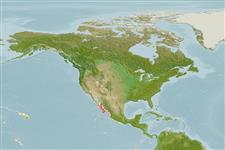>
Blenniiformes (Blennies) >
Chaenopsidae (Pike-, tube- and flagblennies)
Etymology: Acanthemblemaria: Greek, akantha = thorn + Greek, emblema, -atos, anything that is nailed, knocked in; also anything with bass or high relief (Ref. 45335); hastingsi: Named for Philip A. Hastings..
Environment: milieu / climate zone / depth range / distribution range
Ecologia
marino demersale; distribuzione batimetrica 1 - 3 m (Ref. 84469). Tropical
Eastern Pacific: Gulf of California (limited to Mulegé to Cabo San Lucas along the Baja Peninsula and between Isla San Pedro Nolasco and Isla San Ignacio de Farallon along the Mexican continental mainland, Ref. 26771).
Size / Peso / Age
Maturity: Lm ? range ? - ? cm
Max length : 5.1 cm SL maschio/sesso non determinato; (Ref. 84469); 4.0 cm SL (female)
Short description
Morfologia | Morfometria
Spine dorsali (totale): 23 - 25; Raggi dorsali molli (totale): 12-14; Spine anali 2; Vertebre: 42 - 44. This species is distinguished from its congeners in the Pacific, excluding its closest relatives, A. macrospilus and A. mangognatha, by having a single row of large brown blotches along its lateral midline and head spines that are pointed (vs. club-like or ridge-like). It differs from the 2 latter species by having a dark swath of melanophores on the dorsal fin in both males and females that highlights the bright orange coloration on that fin; presence of scattered melanophores reaching the tip of the lower jaw; and expression of orange as the primary bright head color. This species is further distinguishable from A. macrospilus by the 71 fixed mutations in COI and 20 fixed mutations in the D-loop region of its mitochondrial genome (Ref, 84469).
Life cycle and mating behavior
Maturità | Riproduzione | Deposizione | Uova | Fecundity | Larve
Lin, H.-C. and G.R. Galland, 2010. Molecular analysis of Acanthemblemaria macrospilus (Teleostei: Chaenopsidae) with descriptions of a new species from the Gulf of California, Mexico. Zootaxa 2525:51-62. (Ref. 84469)
IUCN Red List Status (Ref. 130435)
Threat to humans
Harmless
Human uses
Informazioni ulteriori
Nomi ComuniSinonimiMetabolismoPredatoriEcotossicologiaRiproduzioneMaturitàDeposizioneSpawning aggregationFecundityUovaEgg development
Age/SizeAccrescimentoLength-weightLength-lengthLength-frequenciesMorfometriaMorfologiaLarveDinamica popolazioni larvaliReclutamentoAbbondanzaBRUVS
BibliografiaAcquacolturaProfilo di acquacolturaVarietàGeneticaElectrophoresesEreditarietàMalattieElaborazioneNutrientsMass conversion
CollaboratoriImmaginiStamps, Coins Misc.SuoniCiguateraVelocitàModalità di nuotoArea branchialeOtolithsCervelliVista
Strumenti
Special reports
Download XML
Fonti Internet
Estimates based on models
Preferred temperature (Ref.
123201): 23.2 - 28.7, mean 25.6 °C (based on 138 cells).
Phylogenetic diversity index (Ref.
82804): PD
50 = 0.5000 [Uniqueness, from 0.5 = low to 2.0 = high].
Bayesian length-weight: a=0.00457 (0.00183 - 0.01143), b=3.08 (2.86 - 3.30), in cm total length, based on LWR estimates for this (Sub)family-body shape (Ref.
93245).
Trophic level (Ref.
69278): 3.5 ±0.5 se; based on size and trophs of closest relatives
Fishing Vulnerability (Ref.
59153): Low vulnerability (10 of 100).
